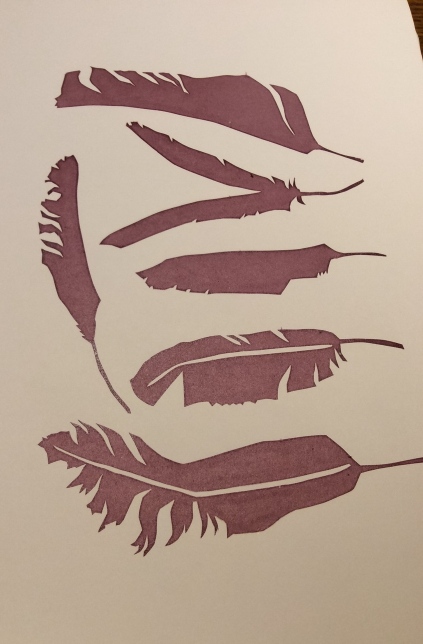November 2015
Gainsborough’s House printmaking workshop weeks 6-9
The final four weeks of the printmaking course at Gainsborugh’s House studio were the reason that I had initially enrolled on the course – for some practical instruction on screen-printing.
Compared with the first five weeks, I was disappointed. We only received tuition in week 6, after that it was down to us to experiment. The difficulty was that we only had one screen allocated to each of us, so every session it was only possible to print one set of runs (there was insufficient time for the screen to be cleaned and dried). Consequently, most students went back to other forms of printing like intaglio or Linocut. I persisted with the screen printing, but I didn’t feel that I’d gained as much from the course as I’d hoped.
I started my making a simple paper stencil and trying a basic print. I used the “fallen feathers” theme from Assignment 1, Exploring ideas.
At first I couldn’t get a clean crisp line (see below). It turned out that I was not putting enough pressure on the squeegee.

Eventually I made a better (although not perfect) print (below)

I experimented by using torn paper stencils to make a second layer (see below)

I Intended to try and create some of the effects of multiple printing in Jane Dunnewold’s book Artcloth (1), and the screen printing publication by Committed to Cloth (2). I think this layering would have been better had I printed the feather design second (on top).
I also tried experimenting with two colours of paint (below) to make an intentionally streaky effect. I don’t really like the outcome, I think because the colours are too similar and it looks muddy.

An image of the torn paper stencil printed on it’s own is shown below.

I love the effect of the torn paper, although the stencils did start to degrade and pull off after approximately 4-5 prints.
I also tried printing over some fabric mesh (net) placed between the screen and the paper. Unfortunately this was not successful, probably because the net was too thick. It also did not adhere properly to the screen so fell off creating a horrible mess and preventing any further printing. In future I could try a small amount of glue.
I also think that rather than printing 3 screen printed images on top of each other it would have been more effective to mix methods (e.g. Dyeing, screen printing, block printing)
References:
1. Dunnewold’s, J. (2010). Art Cloth: A guide to surface design for fabric. Interweave Press. Loveland
2. Benn, C. And Morgan, L. (2009) Screen printing: Layering textiles with colour, texture and imagery. Committed to cloth. Surrey.
